

If you want a device that brings both convenience and broad coverage to your home, red light therapy mats often fit the bill. You can relax on a mat and target large areas of your body at once. Clinical studies show that LED devices, like those used in these mats and panels, help improve skin appearance and wellness. QuasarMD offers both mats and panels, so you have options. Think about your goals—some people need targeted relief, while others want full-body support. Choosing the best red light therapy mat or a powerful panel depends on your space, budget, and what you hope to achieve.
Key Takeaways
- Red light therapy mats are easy to carry and simple to use. They are good for helping certain body parts and for relaxing. Red light therapy panels can treat bigger areas fast. They help muscles heal and make skin healthier. Think about your health goals before picking a device. Mats work well for small spots. Panels are better if you want to treat your whole body. Pick devices with lots of LEDs and FDA approval. This helps make sure the therapy is safe and works well. You can use both mats and panels together for better results. Choose what fits your daily life and what you need for treatment.
Quick Comparison
Key Differences
You may ask what makes red light therapy mats and panels different. Here is a simple way to compare them:
| Feature | Red Light Therapy Mats | Red Light Therapy Panels |
|---|---|---|
| Design | Easy to carry and use, can wrap around your body | Bigger, not easy to move, made for large areas |
| Functionality | Sends red light right to your skin for certain spots | Uses strong LEDs to shine on bigger spaces |
| Treatment Efficiency | Skin gets more light because mat touches it | Can treat many spots at once, saves time |
| Health Benefits | Helps skin, eases pain, helps muscles heal faster | Helps your body heal and feel better inside |
| Cost | Usually cheaper and easier to use at home | Costs more, uses more power, not as easy at home |
Tip: If you want something light and simple, mats are a good choice. If you want to treat big areas fast, panels might be better.
Coverage and Strength
Mats and panels cover your body in different ways. Mats cover the spot you put them on, like your back or legs. They touch your skin, so your body gets more light. This can help with pain and sore muscles.
Panels shine strong light over a bigger area. You can stand or sit in front of a panel to treat your whole body. Panels use stronger LEDs, so the light goes deeper. This means you can finish faster and help your whole body.
- Mats: Good for small spots. You can wrap them around your arms, legs, or back.
- Panels: Good for big areas. They are strong and work fast.
Think about your space and what you want to do. If you want to relax and treat one spot, a mat is nice. If you want a fast, strong session for your whole body, a panel is better.
Red Light Therapy Mats
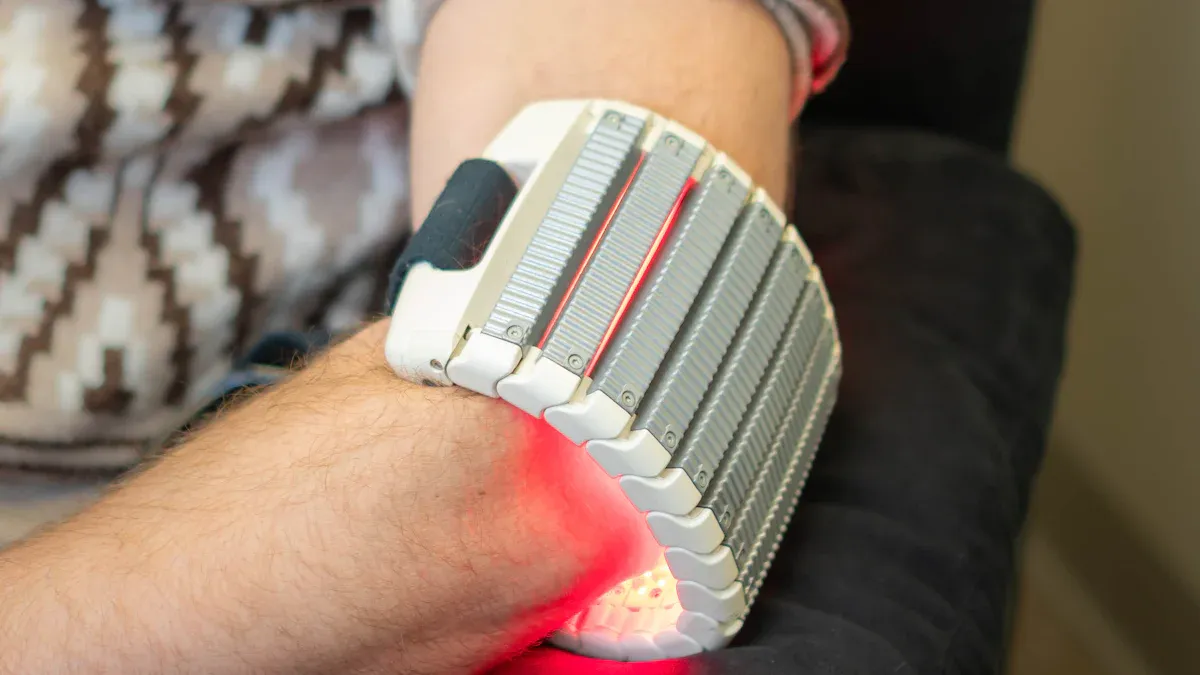
How Mats Work
Red light therapy mats use thousands of tiny LEDs to send gentle red and near-infrared light into your skin. You just lay the mat on a flat surface, plug it in, and relax. The light touches your skin directly, so you get the most out of each session. Many people use mats on their lower back, knees, or shoulders. You can even wrap some mats around your arms or legs. QuasarMD offers mats that are simple to use, even if you have never tried red light therapy before.
Benefits
You will find that mats are affordable, portable, and easy to store. They fit well in small spaces and you can take them anywhere. Mats cover a large area at once, so you do not have to move them around much. Some high-quality mats have thousands of LEDs. For example, the MitoMAT has 3,740 LEDs, and the MitoPOD has 6,960 LEDs. This means you get strong, even coverage.
Many people use mats for pain relief. Studies show red light therapy can help with pain from arthritis, fibromyalgia, knee problems, and even after surgery. In one study, people with chronic low back pain saw their pain drop from 6.9 to 3 on a 10-point scale. You may also notice less morning stiffness and better movement.
Tip: If you want a simple way to try red light therapy at home, mats are a great starting point.
Here is a quick look at the price range for popular mats:
| Product Description | Price |
|---|---|
| Red Light Therapy Mat | $279 |
| Medical-grade Red Light Therapy Pad | $129 |
| SNP2200 Red Light Therapy Pod | $459 |
| SNP300 Infrared PEMF Mat | $289 |
| ShineNova SNP1300 Red Light Therapy Blanket | $279 |
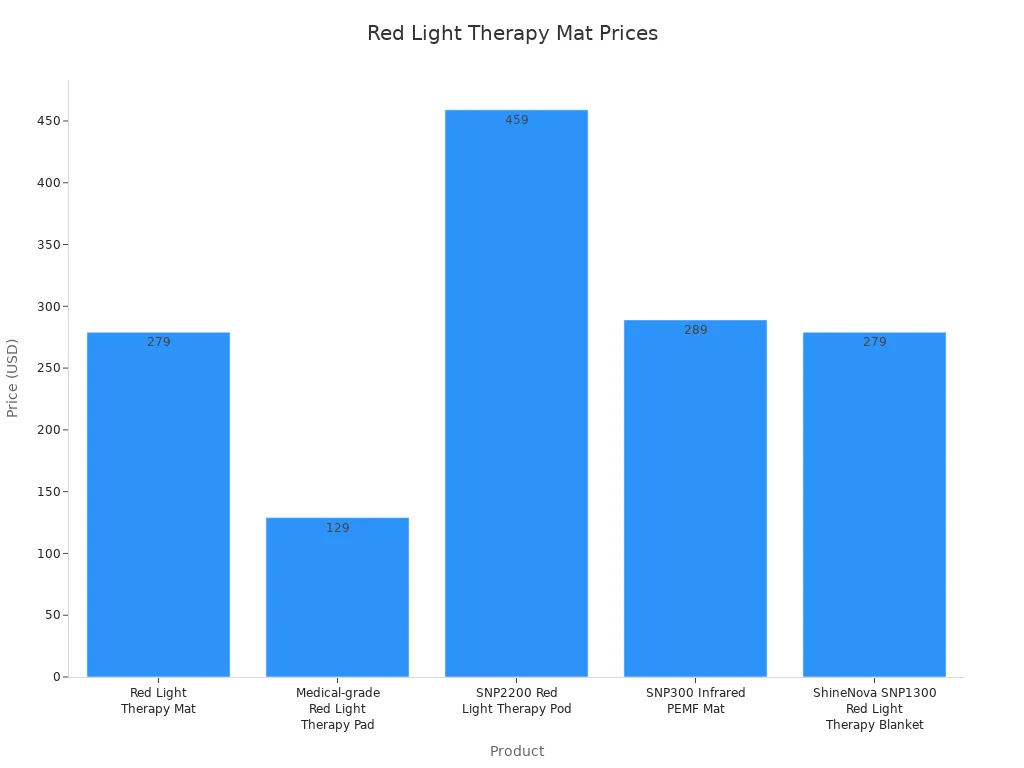
Drawbacks
You might notice some mild redness or dryness after using a mat, especially if you have sensitive skin. Some people see temporary pigment changes or feel a little eye strain from the bright lights. Rarely, burns or blisters can happen if you use the mat for too long or if the device is not made well. If you take certain medicines, your skin might react more to the light. Always check the instructions and start with short sessions.
Best Red Light Therapy Mat Features
When you look for the best red light therapy mat, check for these features:
- High LED count for strong, even coverage
- Flexible design so you can use it on different body parts
- Simple controls and clear instructions
- Lightweight and easy to store
- Trusted brands like QuasarMD
The best red light therapy mat should fit your needs, feel comfortable, and give you the results you want. If you want to target pain, boost recovery, or just relax, a quality mat can help you reach your wellness goals.
Red Light Therapy Panels
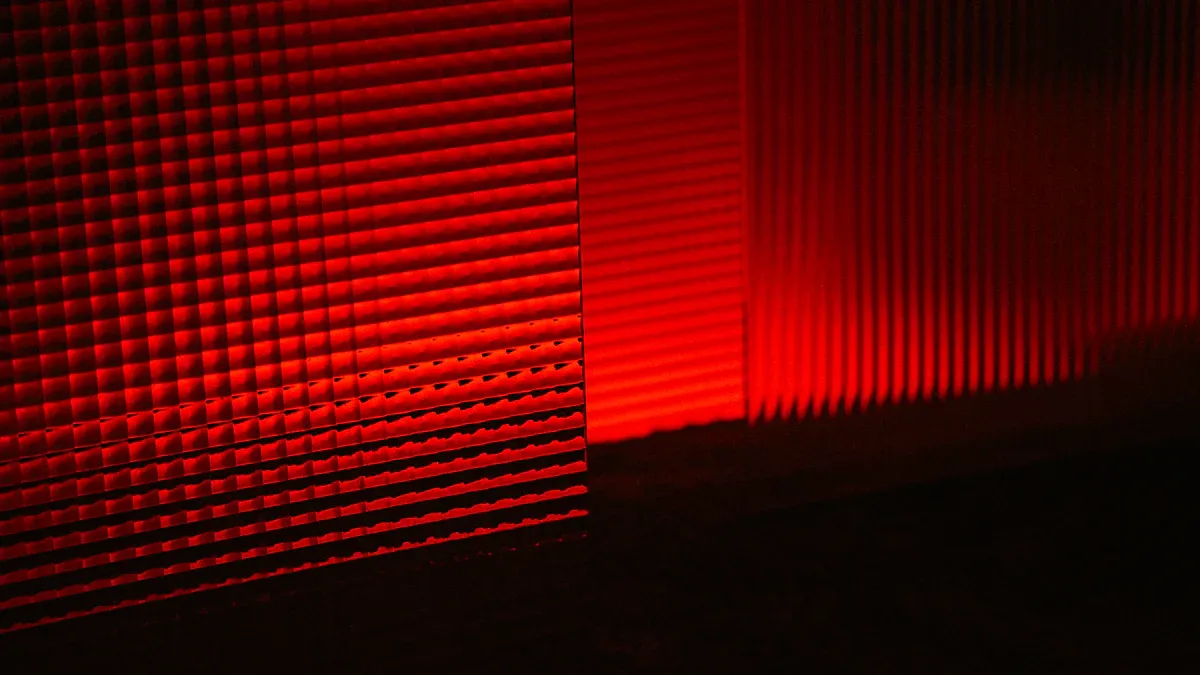
How Panels Work
Red light therapy panels use powerful LEDs to shine light over large areas of your body. You stand or sit in front of the panel. The light covers your skin without touching it. Most panels have adjustable settings, so you can pick the brightness and timer. You get strong light that goes deep into your muscles and skin. QuasarMD offers panels with high-quality LEDs for home use.
Panels have higher irradiance than mats. This means they deliver more energy to your skin. Some top panels reach up to 90 mW/cm². You can see how different panels compare in the chart below.
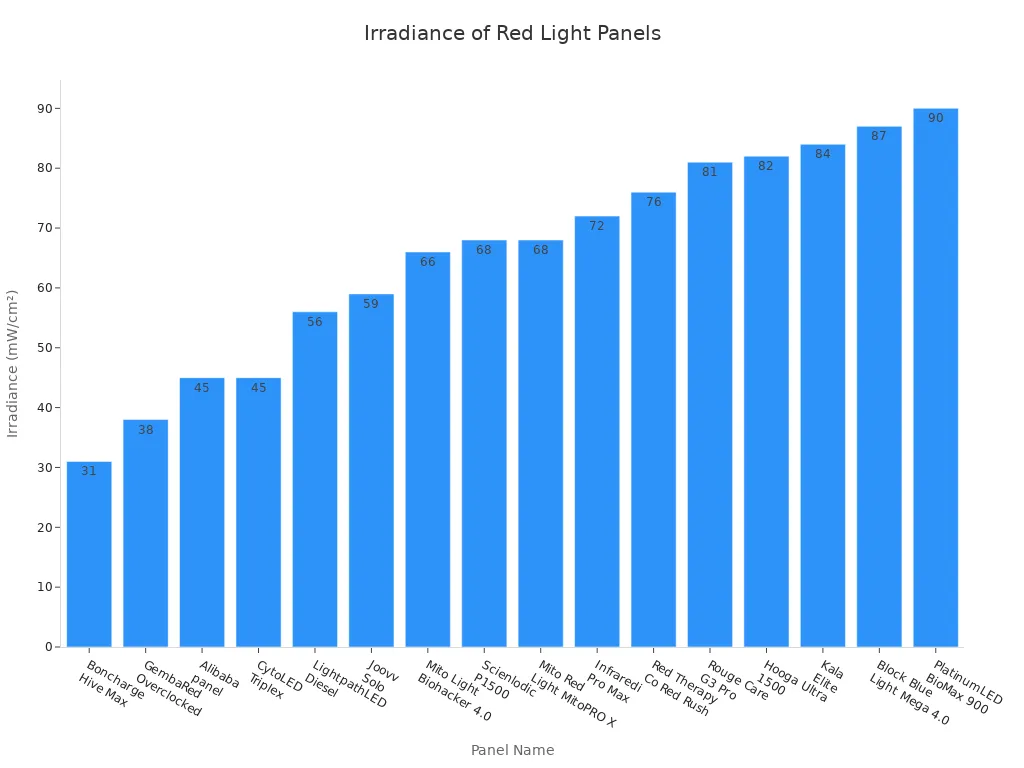
Benefits
You get fast and effective treatment with panels. They cover big areas, so you can treat your whole body in one session. Many athletes use panels to help muscles recover after exercise. Clinical studies show red light therapy can boost endurance, reduce soreness, and speed up healing. You may notice smoother skin, fewer wrinkles, and less redness. Research shows that red light therapy increases collagen, helps wounds heal, and improves skin conditions like acne and eczema.
Here are some reasons people choose panels:
- Strong light reaches deep into your skin and muscles.
- You can treat more than one area at a time.
- Panels work well for skin health and muscle recovery.
You can find panels in different price ranges. Here is a quick look at popular options:
| Product Name | Price (USD) | Shipping (USD) | Total (USD) |
|---|---|---|---|
| Hooga HGPRO300 | $242 | Free (USA) | $242 |
| Mito Red MitoPRO 300 | $332 | Free (USA) | $332 |
| Dermabeam Supreme 300W | $450 | Free (USA) | $450 |
| ROJO 300 | $400+ | Varies | $400+ |
Drawbacks
Panels can be bulky and heavy. You may need extra space to set them up. They are not easy to move around. Some panels have complex controls that take time to learn. If you want something simple and portable, mats might suit you better. Panels also cost more than mats. You need to follow safety instructions to avoid eye strain or skin irritation. QuasarMD offers panels with clear guides to help you use them safely.
Tip: If you want strong, full-body treatment and have enough space, panels are a great choice for your home.
Comparison
Full-Body vs. Targeted Use
When you want to treat your whole body, panels usually work faster and cover more space. Panels use high-intensity LEDs that shine on large areas at once. You can stand or sit in front of a panel and get a quick, deep treatment. Mats, on the other hand, give you broad but gentle coverage. You can lie down and relax while the mat works on your back, legs, or shoulders. Mats feel great for general wellness and relaxation. If you want to focus on one spot, like your knee or lower back, a mat might be the best choice. For full-body results, panels often win in efficiency.
Portability
You might want to use your device in different rooms or even take it on a trip. Mats make this easy. Many mats fold up and have carrying straps, so you can move them around or pack them in a bag. People love how portable these mats are. You can use them at home, at work, or even on vacation. Panels are bigger and heavier. They usually stay in one place. If you want something you can move and store easily, mats are the way to go.
- Mats fold up and fit in small spaces.
- Panels need more room and are harder to move.
Cost
Price matters when you pick a device. Mats usually cost less than panels. You can find a good mat for a few hundred dollars. Panels, especially full-body ones, can cost much more. Here’s a quick look at the price ranges:
| Device Type | Price Range |
|---|---|
| Lamps | $25 to $250 |
| Half-body panels | $300 to $3,000 |
| Full-body panels | Up to $7,000 |
| Specialist devices (mats) | $300 to $1,000 |
| Face masks | $300 to $500 |
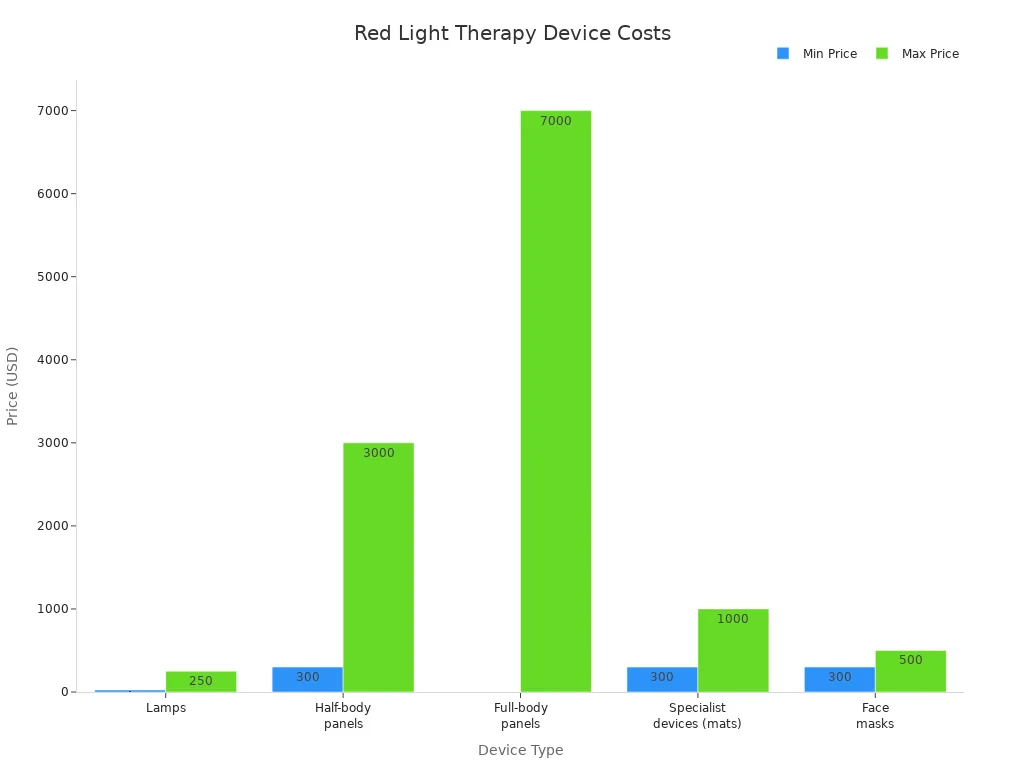
If you want the best red light therapy mat, you can get great features without breaking the bank.
Ease of Use
You want a device that fits your lifestyle. Mats are simple. You just lay them out, plug them in, and relax. Most mats have easy controls and clear instructions. Panels can be a bit more complex. You might need to adjust the height or settings. Some panels have timers and brightness controls that take time to learn. If you want something quick and easy, mats are a great pick. If you like more options and don’t mind a learning curve, panels might suit you.
Tip: Choose the device that matches your daily routine. Simple is sometimes best!
Which to Choose
Matching to Wellness Goals
You want the best results from your red light therapy device. Start by thinking about your main goal. Do you want pain relief, better skin, or faster muscle recovery? Each goal needs a different approach.
Here’s a simple table to help you match your needs to the right device features:
| Feature | What to Look For | Why It Matters for Pain |
|---|---|---|
| Wavelengths | Red (630-660 nm) + NIR (810-850 nm) | Red light calms surface pain. NIR goes deeper to muscles and joints. |
| Irradiance | At least 100 mW/cm² at the right distance | Higher power means faster, stronger results. |
| Device Type | Panel for large areas, mat for targeted spots | Shape and size must fit your pain area. |
| FDA Classification | FDA-cleared (Class II Medical Device) | Shows the device meets safety standards. |
| Third-Party Testing | Independent lab reports | Proves the device works as promised. |
If you want to treat your whole back or legs, a panel covers more space. For knees or shoulders, a mat or wrap works better. Always check the device’s power and wavelength. These details make a big difference in how well the therapy works.
Tip: Health professionals say higher irradiance and the right wavelengths (633–850 nm) help you get better results in less time.
You also want to think about safety. Most people only see mild side effects, like redness or dryness. Some skin types may react differently. Take a look at this chart to see how different skin types handle red light therapy:
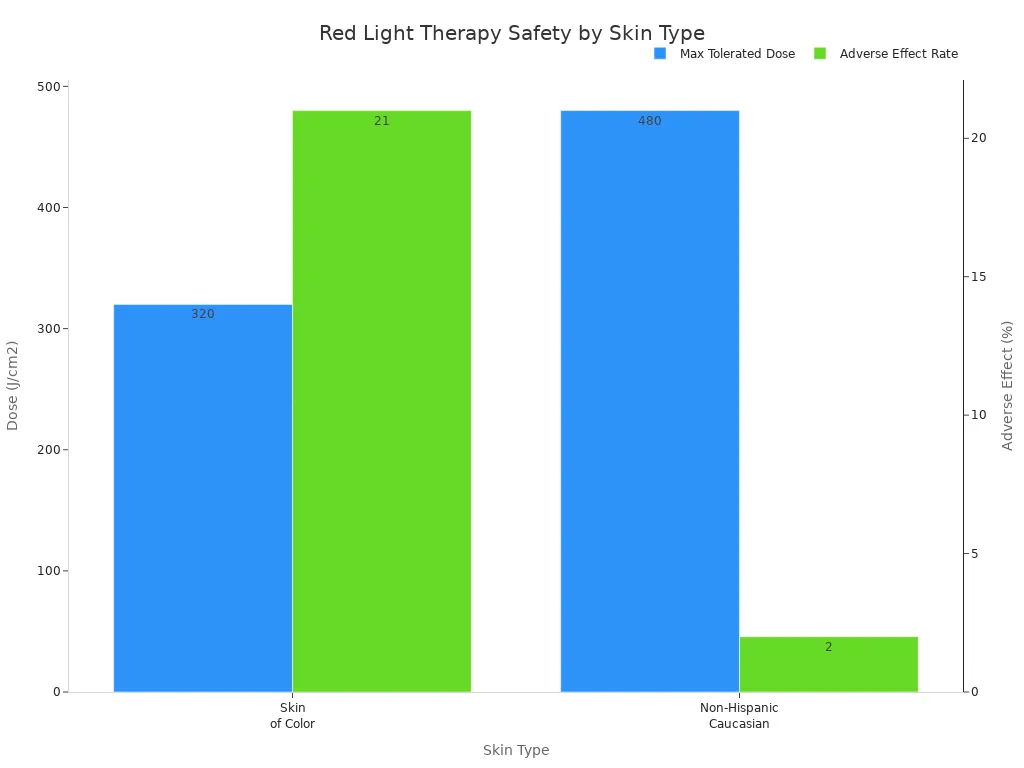
Most side effects go away on their own. If you have sensitive skin, start with shorter sessions.
Choosing between a red light therapy mat or panel depends on what you want. Many people love mats for a relaxing, full-body session while lying down. Others pick panels for quick, targeted treatments. Experts say you should look for adjustable settings, trusted brands, and FDA clearance for safety. QuasarMD offers both options, giving you medical-level results at home. When you decide, think about these key factors:
- Irradiance for deeper results
- Red and near-infrared wavelengths
- Number of LEDs for coverage
- Value for your money
Pick the device that fits your lifestyle and wellness goals best!
FAQ
Can you use a red light therapy mat and panel together?
Yes, you can! Many people use both for better results. Try a mat for relaxing sessions and a panel for quick, deep treatments. Just follow the instructions for each device.
How long should you use red light therapy at home?
Most sessions last 10 to 20 minutes. You can use your device three to five times a week. Always check your device’s manual for the best timing.
Is red light therapy safe for kids and pets?
Red light therapy is gentle, but you should talk to your doctor before using it on kids. Keep pets away from the light unless your vet says it’s safe.
Do you need to wear eye protection?
It’s a good idea to wear eye protection, especially with panels. The light can feel bright and may cause eye strain. Many devices come with safety goggles.
How soon will you see results from red light therapy?
You might notice changes in a few weeks. Some people feel better after just a few sessions. Results depend on your goals and how often you use the device.

